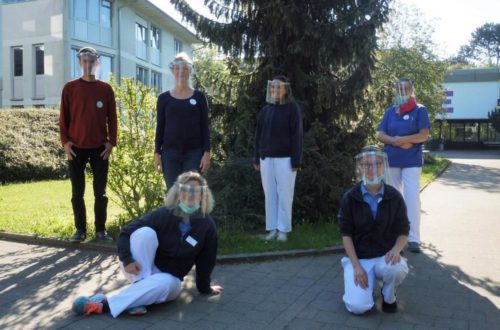The speed of life: a zoo of cells to study developmental time
In humans, pregnancy lasts around nine months. In mice, only 20 days, and in rhinoceroses, as long as 17 months. Although many mammalian species go through the same stages during embryo development, the speed of development differs substantially across animals. Another example of an event that differs in time across species is the formation of the vertebrate body axis, the spine. The formation of the body segments that will give rise to the vertebrae and ribs, called somites, is controlled by a mechanism called segmentation clock. The segmentation clock is a group of genes that oscillates. Each oscillation controls the formation of a pair of somites. The frequency of the oscillations differs across species, taking two to three times longer in humans compared to mice.
The segmentation clock is a convenient system to study differences in species, and the Ebisuya group has been studying it for a long time, recently revealing that thedifferences in biochemical reaction speeds are responsible for the differences in the mouse and human clocks. However, in order to establish whether this is a general principle of development, researchers needed to broaden the species that have been studied, which up to now has been relatively limited to human and mouse.
Now, researchers from the Ebisuya Group have recapitulated in the lab the segmentation clock of four novel mammalian species, in addition to mouse and human: marmoset, rabbit, cattle and rhinoceros. This work has been done in collaboration with research groups based in Europe, Japan and the United States.
What is a stem cell zoo?
A stem cell zoo is like a library of stem cells from several species to study and compare different developmental events. The collaboration group collected embryonic stem cells and induced pluripotent stem cells from marmoset, rabbit, cattle and rhinoceros, which added to the already existing library of human and mouse. This diverse sampling of species is unprecedented for developmental studies, and aims to constitute a platform for comparison of developmental processes.
“We wanted to create a platform of cells from several mammalian species to study why their developmental time is different. We wanted to have as wide a range as possible, so we chose species with body weights spanning from 50 grams to 2 tonnes, gestation lengths from 20 days to 17 months, and three different evolutionary histories or phylogenies: Primates (human and marmoset), Glires (mouse and rabbit) and Ungulates (cattle and rhino).” said Jorge Lázaro, pre-doctoral student at Ebisuya Group and first author of the paper.
The group focused on studying the differences in the segmentation clock of the four new species. They applied experimental protocols to differentiate the embryonic and induced pluripotent stem cells into pre-somitic mesoderm like cells, the cells that will give rise to the spine, ribs and skeleton muscles.
“Our stem cell zoo serves as an ideal platform to investigate the cause of interspecies differences in the segmentation clock period, as well as to determine whether there is any general relationship between segmentation tempo and the characteristics of the organism.” said Miki Ebisuya, Group Leader at EMBL Barcelona and at the Cluster of Excellence Physics of Life, TU Dresden.
Correlating the segmentation clock
The gestation length, as well as many other bodily parameters are known to scale with the animal body weight. Larger species tend to have a longer gestation period. The group thus hypothesized that the differences in the segmentation clock could be related to body weight. However, surprisingly they found no correlation between the average body weight of each of the species and its segmentation clock period. Similarly, the gestation length did not correlate with the segmentation clock period.
Instead, the group found that the segmentation clock period was highly correlated with the duration of embryogenesis. Embryogenesis is the time between fertilisation until the end of organogenesis, when all organs are formed in an embryo. This could mean that the segmentation clock can serve as a good system to understand how general embryonic developmental time is established across species.
Furthermore, the group found that the three different evolutionary histories – Primates, Glires and Ungulates –, corresponded with slow, fast and intermediate segmentation clock periods respectively, pointing to a relation between developmental tempo and evolutionary groups.
In previous studies, the Ebisuya group already found thatbiochemical reaction speeds scale with the segmentation clock period. However, those studies focused on mice and human. The group has now extended the species under study and has confirmed that the four new mammals also show differences in the biochemical reactions speeds, correlating very well with the segmentation clock period. That indicates that changes in the biochemical rates might be a general mechanism to control developmental tempo.
Moreover, they found that genes related to biochemical processes show an expression pattern that correlates with the segmentation clock period, providing a concrete clue for a potential molecular mechanism underlying the differences in developmental speeds across species.
“Our aim is to keep adding species in our stem cell zoo,” said Ebisuya. “If we want to confirm whether the findings of our research could constitute a universal principle of mammalian development, we need to expand the zoo and include a wider range of species and phylogenies.”
In the current study published in Cell Stem Cell, the group focused on the segmentation clock, but the stem cell zoo approach opens the possibility to study other biological times such as the heart rate or the lifespan. The more researchers know about how biological time works, the more they might be able to control it. For example, in the field of organoids, if one could accelerate the time required to develop organoids, it could speed up regenerative medicine studies.
“Another aspect that I really like about the stem cell zoo is the possibility to learn from different species outside of human and mouse,” said Lázaro. “Many animals have particular features that make them interesting to study, but due to practical or ethical reasons we don’t have access to them in the lab. Features like for example the size of a rhino, or the long neck of giraffes. Who knows, perhaps in our next project we can use stem cells to try to understand how do giraffes develop their long neck – and longer somites!”
EMBL Heidelberg
Meyerhofstraße 1
69117 Heidelberg
Telefon: +49 (6221) 387-0
Telefax: +49 (6221) 387-8306
http://www.embl.de
Press Officer
E-Mail: lisa.vollmar@embl.org
![]()



